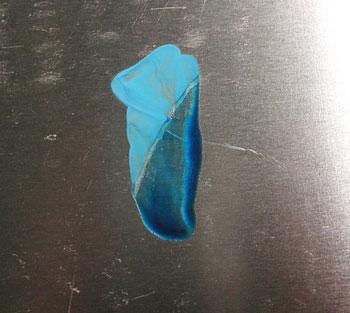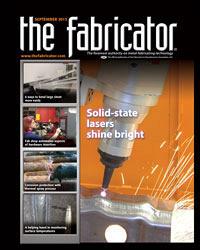Welding Instructor
- FMA
- The Fabricator
- FABTECH
- Canadian Metalworking
Categories
- Additive Manufacturing
- Aluminum Welding
- Arc Welding
- Assembly and Joining
- Automation and Robotics
- Bending and Forming
- Consumables
- Cutting and Weld Prep
- Electric Vehicles
- En Español
- Finishing
- Hydroforming
- Laser Cutting
- Laser Welding
- Machining
- Manufacturing Software
- Materials Handling
- Metals/Materials
- Oxyfuel Cutting
- Plasma Cutting
- Power Tools
- Punching and Other Holemaking
- Roll Forming
- Safety
- Sawing
- Shearing
- Shop Management
- Testing and Measuring
- Tube and Pipe Fabrication
- Tube and Pipe Production
- Waterjet Cutting
Industry Directory
Webcasts
Podcasts
FAB 40
Advertise
Subscribe
Account Login
Search
Monitoring surface temperatures with phase-change materials
Melting point standards simplify measurement in welding, manufacturing
- By Claude Bedingfield
- September 5, 2013
- Article
- Testing and Measuring

Figure 1: When the dry, opaque mark of a temperature-indicating stick changes to a melted appearance, its temperature rating has been reached.
For measuring surface temperatures, one of the simplest and most effective methods is the use of temperature-indicating products based on the absolute, predictable phase change (solid to liquid) of a pure chemical compound.
Melting point—the temperature at which phase change occurs—is a physical property; nothing affects it, and it occurs, simply and reliably, every time the exact temperature is reached. Phase-change temperature indicators are not influenced by external factors such as static electricity, ionized air, time, humidity, or impact. The melting point never needs calibration.
Types of Phase-Change Indicators
The first phase-change temperature indicator was a stick used to mark the workpiece in welding applications. Temperature-indicating sticks now are available for measuring exact temperatures, from 100 to 2,000 degrees F. While they come in a variety of identifying colors, the color has nothing to do with the temperature-indicating process. When the dry, opaque mark changes to a distinct, well-defined melted appearance (see Figure 1), the temperature rating of the stick has been reached.
Pellets are another option. They are placed on or inside the workpiece, such as in an annealing furnace. Liquids, which are painted on the workpiece, are composed of phase-change materials suspended in an inert, volatile, nonflammable vehicle. They may be used to mark polished metals, glass, and other smooth or shiny, difficult-to-mark surfaces or those not readily accessible for application of a crayon mark during the heating process. Both pellets and liquids change from dry to wet (melted) when they reach their temperature rating (see Figure 2).
Temperature-sensitive labels are coated with temperature-indicating material and affixed to a component to measure temperature exposure. The center of a heat-sensitive indicator, sealed on the label under a transparent window, turns permanently from white to black at the temperature rating. Labels provide rapid data acquisition without any wires or readout boxes. They are suitable for measuring temperatures in isolated systems, on moving or rotating assemblies, or wherever other recording instruments are impractical. Applications include monitoring the operating conditions of electronic parts, transformers, resistors, and circuit-board components.
Accuracy
The accuracy of phase-change materials for surface temperature indication is usually within 1 percent—for example, within 3.5 degrees at 350 degrees F. This accuracy is achieved because the stick, label, or liquid is in direct contact with the workpiece and thus in thermal equilibrium with the surface to be tested.
A phase-change indicator does not, of course, tell the exact temperature as a thermometer would. However, it does determine exactly when a preset minimum or maximum temperature has been reached. For checking one or a few limit points, phase-change material is an accurate, cost-effective method.
Applications
Phase-change materials are used to measure temperatures in welding preheat, interpass, postweld heat treatment, cool-down, and annealing. They also are used to measure the temperature of equipment used on a job, in applications varying from racing car engines to electronic components—particularly where the surface may be moving, rotating, or inaccessible. And they are used to determine temperatures for diagnostic work and warranty information.
Preheat almost always is required or recommended for welding, particularly for surface welding and joining of thick or hardenable, higher-strength alloys. Bringing the base metal up to heat before welding reduces the danger of crack formation. Since preheat is an inexact science, with metal thickness and other factors affecting the necessary duration before the desired temperature is reached, the temperature indicators are used to ensure the recommended level of preheat has been achieved and maintained.
A phase-change indicator of a desired calibrated temperature can be used to mark the workpiece before heating begins, or it may be stroked on the piece as heating proceeds. Pellets occasionally are placed on the surface of the workpiece for preheat indication, but they typically are employed in higher-temperature and more prolonged heat-treating applications.

Figure 2: Temperature-indicating liquids, which are painted on the workpiece, change from dry to wet (melted) when they reach their temperature rating.
Maintenance of minimum and maximum interpass temperatures promotes ductility, reduces brittleness, increases toughness, improves weld controllability, reduces hard zones next to the weld area, and reduces distortion of surrounding surfaces. It also increases diffusion of hydrogen from the metal to limit weld contamination and tends to vaporize moisture that might be present.
Following machine welding, a workpiece might need to be stress-relieved to an appropriate ductile condition by annealing—a process of controlled reheating that returns the overhardened metal to the approximate hardness of the rest of the material. Correct temperature is extremely important; too much heat will decrease weld strength, while insufficient heat will prevent annealing and leave the weld overhardened and brittle.
Temperature-indicating products are useful tools for the entire welding process.
About the Author
Claude Bedingfield
300 W. Sinclair St.
Gillette, WY 82718
307-686-0254
subscribe now

The Fabricator is North America's leading magazine for the metal forming and fabricating industry. The magazine delivers the news, technical articles, and case histories that enable fabricators to do their jobs more efficiently. The Fabricator has served the industry since 1970.
start your free subscription- Stay connected from anywhere

Easily access valuable industry resources now with full access to the digital edition of The Fabricator.

Easily access valuable industry resources now with full access to the digital edition of The Welder.

Easily access valuable industry resources now with full access to the digital edition of The Tube and Pipe Journal.
- Podcasting
- Podcast:
- The Fabricator Podcast
- Published:
- 04/16/2024
- Running Time:
- 63:29
In this episode of The Fabricator Podcast, Caleb Chamberlain, co-founder and CEO of OSH Cut, discusses his company’s...
- Trending Articles
Capturing, recording equipment inspection data for FMEA

Tips for creating sheet metal tubes with perforations

Are two heads better than one in fiber laser cutting?

Supporting the metal fabricating industry through FMA

Omco Solar opens second Alabama manufacturing facility

- Industry Events
16th Annual Safety Conference
- April 30 - May 1, 2024
- Elgin,
Pipe and Tube Conference
- May 21 - 22, 2024
- Omaha, NE
World-Class Roll Forming Workshop
- June 5 - 6, 2024
- Louisville, KY
Advanced Laser Application Workshop
- June 25 - 27, 2024
- Novi, MI


























